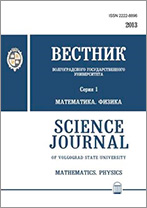|
Computer modelling
Computer modeling of ultra-short optical pulses interaction in silicene
N. N. Konobeeva
Volgograd State University
Abstract:
There is considerable interest in studying materials with graphene-like structures possessing unique electrical properties, which are promising for micro- and nanoelectronics. One of these materials is silicone - a monolayer of silicon atoms with a hexagonal lattice, which is characterized by a stronger spin-orbit interaction as compared to that in graphene. In addition, it is important that silicon is still the main element in modern electronics.
In this paper we investigate the problem of modeling the ultra-short optical pulses propagation and interaction in silicene. Electrons were considered in long-wave approximation for Hamiltonian in the case of law temperatures. The dependence of pulse form on its amplitude was obtained. The obtained results show that interaction between the ultra-short optical pulses may be useful in light controlling device and can be, for example, the base for an analog comparator of pulse amplitudes.
It should be noted, that when pulse speed increases then the magnitude of the spatial localization of a solitary pulse and the time over which a single pulse "passes" through the other decrease. All this leads to the fact that the effects associated with the nonlinear interaction of pulses does not have time to develop, and the collision is an "elastic" way.
Keywords:
computer modeling, silicene, ultra-short optical pulses, collision, Maxwell equations.
Citation:
N. N. Konobeeva, “Computer modeling of ultra-short optical pulses interaction in silicene”, Vestnik Volgogradskogo gosudarstvennogo universiteta. Seriya 1. Mathematica. Physica, 2015, no. 1(26), 40–46
Linking options:
https://www.mathnet.ru/eng/vvgum6 https://www.mathnet.ru/eng/vvgum/y2015/i1/p40
|

| Statistics & downloads: |
| Abstract page: | 233 | | Full-text PDF : | 75 | | References: | 50 |
|




 Contact us:
Contact us: Terms of Use
Terms of Use
 Registration to the website
Registration to the website Logotypes
Logotypes








 Citation in format
Citation in format 